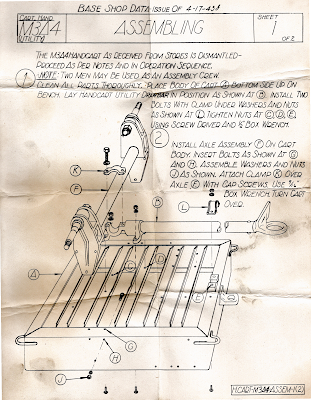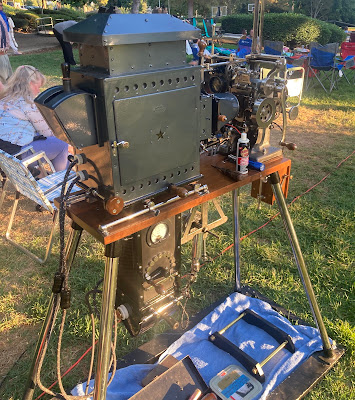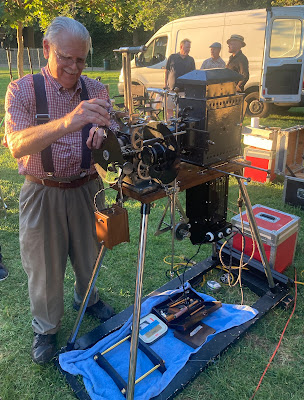The Magic Lantern And Its Applications
By L. H. Laudy PH. D.
Attachments For Polarized Light.
Published in Anthony's Photographic Bulletin
Vol. 17. No. 9.
May 8, 1886
Light which has been refracted from certain surfaces, or transmitted through certain substances under certain special conditions, assumes new properties, and is no longer reflected, refracted or transmitted, as is ordinary light. This change in the action of light is called polarization, and rays thus modified are said to be polarized. This phenomenon was discovered in 1808 by Malus, a young engineer officer of Paris.
According to the undulatory theory, a ray of common light contains vibrations in all planes passing through the ray. In polarized light the vibrations are reduced to one plane only. The term polarized, as applied to light, is an unfortunate one, but it is too firmly engrafted upon science to be changed for a better name, and we are still obliged to use it. It originated from the analogy of two ends of a magnet, which consist of poles; and as the beam of light was said to have sides and ends, it was called polarized. Strictly and scientifically speaking, it is light vibrating in one plane.
There are four principal methods by means of which a beam of light may be polarized: the are, reflection, ordinary refraction, double refraction, and absorption. To of these methods only can be used practically for purposes of projection with the lantern: they are double refraction and ordinary reflection. Any instrument used to polarize light is called a polarizer, and the instrument to examine the light polarized is called an analyzer, and either may be used to polarize or analyze. A large number of crystals possess the property of double refraction -- that is, a ray of light in passing through a double refracting crystal is divided into two rays -- hence an object seen through one of these crystals appears double (Fig. 36). Such a crystal possessing this property to a high degree is Iceland spar, and if we look at a dot or letter or line, a double image will be perceived, as two dots, two letters two lines, etc. Now the light in passing through is divided into two rays, one of which is called the ordinary, the other the extraordinary ray, and both are polarized. The ordinary image will seem slightly nearer to the eye than the extraordinary, and if the crystal to be turned round, the ordinary image will continue fixed, and the extraordinary will describe a circle around it.

The objection to the use of a natural rhombohedron of Iceland spar, is that it gives two rays, one of which must be suppressed. This was most perfectly accomplished by the invention of the Nicol prism, which is made by cutting a rhomb of Iceland spar along a diagonal plane, and then cementing the two pieces together in their natural position by Canada balsam, whose refractive index is intermediate between the ordinary and extraordinary indices of the crystal. A ray of common light suffers double refraction on entering the prism, but the ordinary ray is totally reflected on meeting the first surface of the balsam, and is thrown to one side, while the extraordinary ray passes through the balsam, and emerges at the end of the prism parallel to the original ray (Fig. 37). The lateral faces of this compound prism are all painted black, leaving only the terminal faces for the transmission of the light. The ordinary ray suffers total reflection , and is absorbed by the blackened side of the prism.

The Nicol prism is the most valuable means of polarizing light; yet, while it more perfectly polarized the light than the bundle of glass plates, it produces a small beam or circle, which is not governed by the distance of the lantern from the screen, but by the size of the prism. To secure total reflection of one ray, its length must be considerably greater than its breadth, and this necessarily limits the divergence of the transmitted beam; yet by its use you get a colorless pencil of light, perfectly polarized, from 20 to 27 degrees in breadth.
With the use of the Nicol prism as the polarizer, the lantern is parallel with the screen, which has some advantages.
Large pieces of Iceland spar are scarce and very difficult to obtain, and for this reason other methods are used to polarize the light; and next to the Nicol prism in efficiency is the Foucault prism, which differs from the former in employing a film of air instead of Canada balsam, and the two halves of the prism being about one-third as long as the Nicol. The objections to its use is that it has a less angular field, and the light used must be parallel, while there is a large loss of light by two reflections. (Fig. 38.)

The third method is by means of single reflection with a bundle of glass plates set at an angle of 56 degrees, that being the angle of polarization for glass. (Fig. 39.) The plates of glass used should be about one-twentieth of an inch thick, fifteen to twenty in number, of good quality, and about 5x8 or large enough to receive the full beam of parallel light from the condensers. The plates are mounted in a metal frame or elbow, which is firmly attached to the front of the lantern. Fastened to the front of the elbow, or on a separate stand, is placed a plano-convex lens and a small Nicol prism about three-quarters of an inch across its longest diagonal. A smaller one can be used such as comes with the microscope, and will yield fairly good results. The Nicol, this termed for the sake of brevity, must be so mount3e din front of the lens, and be so placed in the focus, that all possible light may pass through it; and by fitting it into a collar can be rotated. (Fig 40 N.)

The great advantage of using the bundle of plates, is that it gives a beam of light the size of which depends upon the distance from the screen, the same as in ordinary lantern projections, and the cost of the apparatus is much less than the use of two Nicol's.
The objection to the use of the bundle of plates is, that as the lantern must be turned at an alge, a large amount of light is lost by absorption; only one-half that is used is reflected, and this in passing through the analyzer is reduced to about 15 percent of the original light.
When using either of these attachments, it is important that the light should be carefully adjusted and made to yield the greatest possible illumination. The plates must be perfectly clean and dry and the outside glass should be covered with black cloth or varnish. The experiments are of the most fascinating character. Many of the objects are prepared from mica or selenite (sulphate of lime), which is an easily procurable crystal, readily cleavable in thin laminae capable of showing the colors of polarized light, and is most frequently employed in experiments on chromatic polarization.
Making use of the principle that the color produced depends upon the thickness of the plate, selenites have been cut of suitable shapes and thicknesses so as to produce colored images of stars, flowers, butterflies and other objects which appear transparent to the eye, but yield the most gorgeous and indescribable display of complementary colors as the analyzer is made to revolve.
If the object or films to be rotated while the polarizer and analyzer remain fixed, the color will appear at every quadrant of revolution and disappear at intermediate positions. When the Nicol is rotated, the colors will change to the complementary at every quadrant; that is the same color will be seen in positions of the analyzers differing 180 degrees, and the complementary will be seen at 90 and 270 degrees.
These methods yield plain polarized light. There are two other forms, elliptical and circular, each of which require additional apparatus, such as a quarter-wave plate or two Fresnel's rhombs, for a full description of which the reader is referred to "Ganot's Physics", "Daguin's Triate de Physique", "Jamin's Physique", "Polarazied Light" by William Spottiswoode F.R.S., "Brewseter's Optics", Pereira's "Lectures on Polarized Light", or Lewis Wright's "Light".
When projecting the larger objects, they occupy the same position in the lantern as the ordinary slide, but by far the larger number of objects are those used with the table microscope, and to project these requires the microscope attachment, which has already been described. It is placed in front of the elbow and the Nicol is place din front of the objective. The entire apparatus is shown in Fig. 41. With this combination it is possible to project many beautiful and highly interesting, objects and study them on a large scale.
The large objects best suited, besides the designs already mentioned, are --
Plates of selenite - giving tints red and green
Plates of selenite - giving tints yellow and blue.
Plates of mica - tints red and green
Plates of mica - tints yellow and blue
Plates of quartz cut parallel to the axis, thin
Plates of quartz cut parallel to the axis, thick
Plates of quarts oblique, giving hyperbolas
Concluding Remarks
No better gift, whether the toy lantern of the more prefect instrument, can be selected, for it is certain to please, is well qualified to convey instruction with the most gratifying results, and it can be applied to a variety of useful, instructive, and eminently attractive purposes. With the aid of photography, geography, and allied sciences, natural history and extended travel to all parts of the earth can be enjoyed without expense and fatigue, and with ta degree of accuracy unknown till their introduction; and to its utility in this direction no limits can be assigned. Need more to be said in its favor? I think not; for it will commend itself to every careful and thoughtful mind, and it is to be hoped that its introduction may be more general in the household, where it will be looked upon with the same importance as the library for imparting useful knowledge.
In a treatise such as this, it is impossible to enlarge upon all that has been done in advancing to the degree of perfection in which we find the lantern today. My object has been to give a simple and in some cases brief description of each lantern, and in so doing call attention to the most important points in connection with their history and application. Much as of necessity been omitted for want of space and time, but I hope that what has been written may lead to a better understanding, awaken an interest in may of my readers, and meet with a kind reception at their hands. Having now completed my task, I take this opportunity to express my thanks to Dr. Elliott for his patience and valuable assistance rendered me in this article; and my thanks are also due to the publishers for the great care which they have bestowed upon the illustrations.
Other References to Victorian Polarized Light Shows:
http://www.microscopy-uk.org.uk/mag/artmay14/jp-retardation.pdf

































































